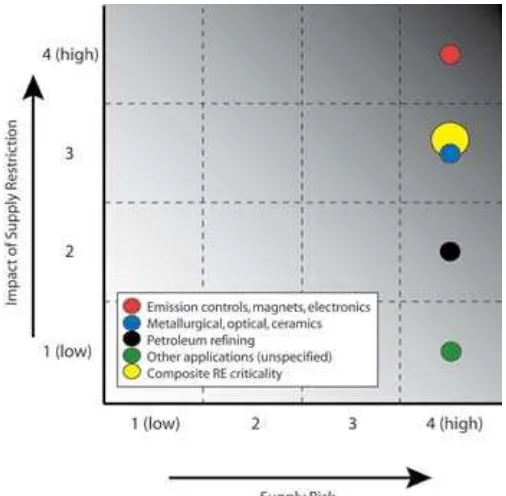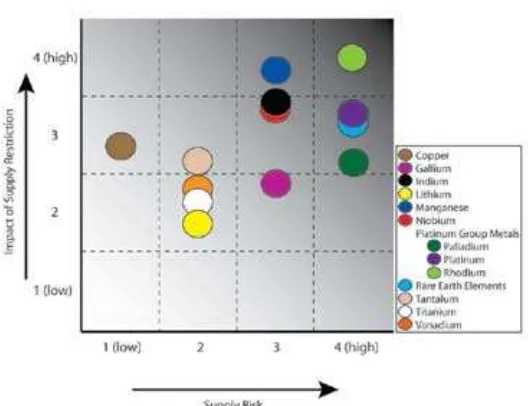Minerals, Critical Minerals, and
the U.S. Economy
M
inerals are part of virtu-ally every product we use. Their unique prop-erties contribute to provision of food, shelter, infrastructure, trans-portation, communications, health care, and defense. Minerals used in common applications include iron to produce steel, copper used in electrical wiring and plumbing, and titanium used for the structur-al frames of airplanes and in paint pigments. Every year over 25,000 pounds (11.3 metric tons) of new minerals must be provided forev-ery person in the United States to make the items that we use every day, and a growing number of these minerals are imported.
The portfolio of minerals needed for man-ufacturing is dynamic. The Information Age is creating demand for an ever-wider range of metallic and nonmetallic minerals to perform essential functions in cellular telephones (e.g., tantalum), liquid crystal displays (e.g., indium), computer chips (a broad mineral suite), and pho-tovoltaic cells (e.g., silicon, gallium, cadmium, selenium, tellurium, and indium). Whereas today’s cars require about 50 pounds of copper to create electrical wiring systems, new hybrid cars will require even more copper—about 75 pounds, by some estimates.
There are a number of reasons for potential supply restrictions. Natural ores can be exhaust-ed or become too dificult to extract
economi-cally or in an environmentally acceptable way. For some miner-als, reliance on supplies from a limited number of mines, mining companies or nations can carry added potential for restriction. Increases in mineral demand with new technology development can also alter mineral prices. For ex-ample, in response to an increase in demand for indium, used in the manufacture of lat screens, the price of indium rose from about $100 per kilogram to $980 per ki-logram between 2003 and 2006. Given the importance of minerals and a growing reliance on imported minerals, con-cerns have been raised that the impacts of po-tential restrictions for mineral supplies have not been adequately articulated, and that federal responsibilities to acquire and disseminate in-formation and conduct research on “critical” minerals are not well deined. The central ques-tion is, will the necessary mineral resources be available in time and at acceptable costs to meet burgeoning demand for current and emerging products and technologies?
mineral supply. The audience for the study includes not only federal agencies, industry, and research organiza-tions, but also the general public and decision makers.
What Makes a Mineral Critical?
The report’s authoring committee developed a “criticality matrix” to aid in assessing a mineral’s de-gree of criticality (Figure 1). The matrix is based on the inding that a mineral is critical if it is both important in use (represented on the y-axis of the matrix) and if it is subject to potential supply restrictions (represented on the x-axis of the matrix). The methodology provides a framework for federal agencies, decision makers, the
private sector, and any user interested in minerals to make assessments about their own “critical” minerals, and upon that basis, to determine what data, informa-tion, and research are needed to mitigate potential re-strictions in the supply of that mineral for an existing or future use.
Factors that affect minerals importance in use Minerals have varying levels of “importance” as a result of the demand for that mineral from different sectors of the U.S. economy. “Importance in use” car-ries with it the concept that some minerals will be more fundamental for speciic uses than other minerals, de-pending on the mineral’s chemical and physical prop-erties (Figure 2). The greater the dificulty, expense, or time to ind a suitable substitute for a given mineral, the greater will be the impact of a restriction in the mineral’s supply.
For example, platinum group metals and rare earth elements are fundamental to the construction and function of automobile catalytic converters. At present,
Figure 2. Applying the criticality matrix. The matrix shows criticality of the group of minerals known as rare earths. The impact of supply restric-tion (on the y-axis) is evaluated by examining the annual quantity of rare earths used in each of four rare earth application groups (red, blue, black, and green circles), and the dificulty in inding substi-tutes for rare earths in those applications. Because no ready substitutes exist for rare earths in emis-sion controls, magnets and electronics, and these applications demand the greatest quantities of rare earths annually, it is assigned a y-axis value of 4. The yellow dot represents the weighted score for all applications of the impact of supply restriction. The high supply risk (a score of 4 on the x-axis) is due primarily to the fact that the U.S. is 100% dependent on foreign suppliers, most of which (76%) is concentrated in a single country (China).
no viable substitutes exist for these minerals in this ap-plication, resulting essentially in a ‘no-build’ situation for catalytic converters should the supply of those min-erals be restricted. These minmin-erals’ importance is high in this application.
Factors affecting availability of minerals
Over the long term (more than about ten years), availability is a function of ive factors: geologic (does the mineral resource exist); technical (can we extract and process it); environmental and social (can we produce it in environmentally and socially accepted ways); politi-cal (how do governments inluence availability through their policies and actions); and economic (can we pro-duce it at a cost users are willing and able to pay).
Many existing and emerging technologies require minerals that are not available in the United States, but a high degree of import dependence for certain miner-als is not, in itself, a cause for concern. However, im-port dependence can expose a range of U.S. industries to political, economic and other risks that vary accord-ing to the particular situation. Informed plannaccord-ing to maintain and enhance domestic economic growth re-quires knowledge of potential restrictions in the supply of minerals, and also the development of strategies to mitigate the effects of those restrictions.
In the short- and medium-term, signiicant re-strictions to supply may occur, leading either to physi-cal unavailability of a mineral or more likely, to higher prices. Risks include the following:
A signiicant and unexpected increase in de-mand, especially if production already is occur-ring at close to capacity.
•
Relatively thin (or small) markets, which may make it dificult to quickly increase production in response to demand.
Production concentrated in a small number of mines, a small number of companies, or a small number of producing countries.
Minerals whose supply consists signiicantly of byproduct production, which may be fragile or risky because availability is determined largely by availability of the main product (for example, gallium as a byproduct of bauxite mining). Markets for which there is no signiicant recov-ery of material from old scrap, which may be more prone to supply risk than otherwise.
Using the Matrix
The report applies the criticality matrix to 11 min-erals/mineral groups: copper, gallium, indium, lithium, manganese, niobium, platinum group metals, rare earth elements, tantalum, titanium, and vanadium (Figure 3). This list should NOT be construed as a comprehensive list of potentially “critical” minerals; but rather those determined by the committee to demonstrate the range of factors over which the matrix methodology could be tested, and which could be reviewed within the time constraints of the study.
Of the 11 minerals that the report examines, plati-num group metals, rare earths, indium, manganese, and niobium, were determined to be most “critical”. Their uses and applications, the dificulty in inding appropri-ate mineral substitutes for these applications, and the risk to their supply for any one of a number of reasons were high enough to place these minerals in or near the critical “zone” of the criticality matrix. While impor-tant applications exist for the other minerals examined in the report (copper, gallium, lithium, tantalum,
tita-•
•
•
•
Committee on Critical Mineral Impacts on the U.S. Economy: Roderick G. Eggert (Chair), Colorado School of Mines; Ann S. Carpenter, U.S. Gold Corporation; Stephen W. Freiman, Freiman Consulting Inc.; Thomas E. Graedel, Yale University; Drew A. Meyer, Vulcan Materials Company (retired); Terrence P. McNulty, T.P. McNulty and Associates, Inc.; Brij M. Moudgil, University of Florida; Mary M. Poulton, University of Arizona; Leonard J. Surges, Natural Resources Canada; Elizabeth A. Eide(Study Director), National Research Council; Nicholas D. Rogers (Research Associate), National Research Council
This report brief was prepared by the National Research Council based on the report Minerals, Critical Minerals, and the U.S. Economy. For more information, contact the Board on Earth Science and Resources at (202) 334-1289 or visit http://nationalacademies.org/besr. Copies of
Minerals, Critical Minerals, and the U.S. Economy are available from the National Academies Press, 500 Fifth Street, NW, Washington, D.C. 20001; (800) 624-6242; www.nap.edu.
Permission granted to reproduce this brief in its entirety with no additions or alterations.
© 2007 The National Academy of Sciences nium, and vanadium), they were identiied as less
critical, either because there were ready substitutes, or because supplies were not potentially prone to restriction at present. The report did not speculate on the potential for new, or frontier, applications to drive new demand for these or other minerals in the future.
Minerals Information and Research
The report concurs with the consensus of pri-vate, academic, and federal professionals that the U.S. Geological Survey (USGS) Minerals Informa-tion Team is the most comprehensive and responsive source of minerals information domestically and in-ternationally, but that the quantity and depth of its data and analysis have fallen in recent years, due in part to reduced or static budgets and to resultant re-ductions in staff and data coverage. As presently conigured, federal information gathering for miner-als does not have suficient authority, autonomy, and resources to appropriately carry out its data collec-tion, disseminacollec-tion, and analysis.
The USGS could add information critical minerals to the types of data it is now collecting. Unfortunately, there is a paucity of information on critical minerals due in part to an inappropriately low level of support for data collection related to mineral resource availability and resource technol-ogy. The report identiies several research areas that are important if critical minerals are to be reliably identiied, if their sources are to be better quantiied, and if extraction and processing technology is to be substantially enhanced.
Well-educated resource professionals are es-sential for fostering the innovation necessary to as-sure resource availability at acceptable costs and with minimal environmental damage.
Unfortunate-ly, the infrastructure for adequate training of profes-sionals to service the mineral sector has declined substantially over the past few decades in almost all industrialized countries, and the current pipeline of training in the United States does not have enough students to ill the present or anticipated future needs of the country.
RECOMMENDATIONS
Recognizing the dynamic nature of mineral sup-ply and demand and of criticality, and in light of the conclusions above, the committee makes the following recommendations:
1. The federal government should enhance the types of data and information it collects, disseminates, and analyzes on minerals and mineral products, espe-cially as these data and information relate to minerals and mineral products that are or may become critical.
2. The federal government should continue to car-ry out the necessacar-ry function of collecting, disseminat-ing, and analyzing minerals data and information. The USGS Minerals Information Team (MIT), or whatever federal unit might later be assigned these responsibili-ties, should have greater authority and autonomy than the USGS MIT does at present. It also should have suf-icient resources to carry out its mandate, which would be broader than the MIT’s current mandate if our recom-mendations are adopted.

